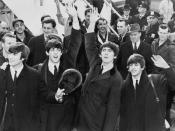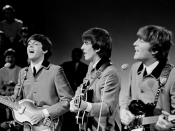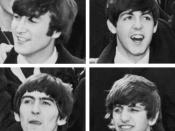In 1964 the Beatles traveled to New York City to appear on a television broadcast ("The Ed Sullivan Show," 1948 to 1971) and launched the so-called British Invasion. Influenced by American recordings, British pop bands of the period invigorated the popular music mainstream and confirmed the international stature of rock music. Soon, several British groups had developed individual distinctive styles: The Beatles combined the guitar-based rock and roll of Chuck Berry and Buddy Holly with the artistry of the Tin Pan Alley style; the Animals blended blues and R&B influences; and the Rolling Stones joined aspects of Chicago blues to their intense, forceful music.
The late 1960s was a period of corporate expansion and stylistic diversification in the American record industry. A new youth-oriented popular market was defined by a broad category of rock music that included the influential studio experiments of the Beatles, San Francisco psychedelia, guitar heroes such as Jimi Hendrix (recorded many of his albums in London) and Eric Clapton (Cream), Southern rock, hard rock, jazz rock, folk rock, and other styles.
As with early rock and roll, the major American record companies did not take the British bands seriously at first-the Beatles' first hit singles in the United States were released through small, independent record companies. Soon, however, the success of the British bands became too difficult to ignore, and some American musicians reacted by developing their own styles. In 1965 Bob Dylan performed live and in-studio with a band that played electric instruments, alienating many folk-music purists in the process. The folk-rock style was further pioneered the same year by the American band the Byrds, who had a number-one hit on the Billboard magazine music charts with a version of Dylan's song "Mr. Tambourine Man." The short-lived group Buffalo Springfield, formed in 1966, blended...


